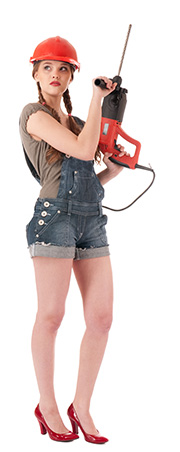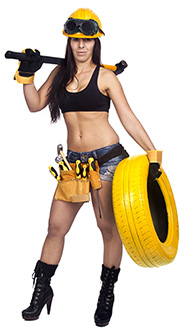- Lighting the working area of the kitchen
- Sockets in the working area of the kitchen
- Sockets on the apron
- Corner sockets
- Furniture sockets
- Hidden socket for the kitchen
- Conclusion

Lamps and sockets on the kitchen apron
Lighting and power sockets in the kitchen thing is quite important. This is especially true of the so-called kitchen work area, where both are simply vital. But how to plan and mount everything so that it is not only functional and safe, but also beautiful. This is what we will discuss in our article.
Lighting the working area of the kitchen
Let's start, perhaps, with lighting, as one of the most important elements. Additional lighting for the working area of the kitchen requires even many regulatory documents. Therefore, we begin our story with these requirements.
According to paragraph 2.12 of the BCH 59 - 88 lighting of the working area of the kitchen must be at least 200lk. The same rule applies to the lighting of the sink. For comparison, the total lighting in the kitchen should be only 100k.
On the basis of this norm for the working area of the kitchen it is necessary to do the so-called local lighting. There are a lot of options for its implementation at the moment, and you will surely find something suitable for your design.
So:
- Let's start with the option of simply installing additional fixtures on the wall . It can be either fluorescent lamps or ordinary lamps for incandescent lamps. The option is quite simple to implement, but not very attractive from an aesthetic point of view.
Note! According to clause 7.1.46 of PUE, all lamps with incandescent lamps in the kitchen installed above the tables should have protective glasses. If fluorescent lamps are installed, they must have protective grilles to prevent the lamps from falling out and to protect them from mechanical damage.

Corner lights for lighting
- A more interesting option may be to install your own corner lights . Usually these are fluorescent lamps, which are mounted with one side to the wall and the other side to the bottom of the upper drawers of furniture. This option allows you to hide the lamp itself.
- An even more interesting option could be the use of spotlights built into the top drawers of furniture. Usually used for this lamp voltage of 12V.
In this regard, you will need to install an additional 220 / 12V transformer. Usually it is mounted outside the furniture, and to the lamps pull the wire voltage is already 12V. For laying such a wire on the wooden surface of the furniture metal corrugation should be used .

Highlight apron in the kitchen
- But the most interesting option is to use the backlight from the apron. This option can be realized when using special glass or plexiglas as an apron. This option is almost perfect both in terms of efficiency and appearance, but its price is the main limiting factor of its distribution.
Sockets in the working area of the kitchen
Equally important for the work area and sockets. They will be connected to a variety of temporary electrical receivers such as food processor, grinder (see Electric meat grinder made in Russia: how to choose ), juicer, toaster, blender and more. Therefore, outlets in the work area should be a lot. Usually set at least three, and sometimes this number comes up to five.
Sockets on the apron
The simplest option to provide the working area of the kitchen with electricity is to install ordinary sockets on an apron (see How to position the sockets in the kitchen correctly and conveniently ). But, as in any other case, there are some nuances.

Outlets on the kitchen apron
So:
- One of those is the height of the outlet on the kitchen apron. There are no clear regulations on regulations in this matter. As says PUE, the main thing is to be comfortable to use. So let's think together.
- If the sockets are located directly above the table top, it will not be very convenient to use. In addition, debris from the table will often get into the sockets, which can lead to negative consequences. Therefore, the socket is usually installed at a height of at least 10 cm from the tabletop.
- But there is another option. If you place the sockets under the very top edge of the apron, then you can visually at least partially hide them. At the same time, it is still convenient to use them.
- Another issue that often arises is the location of the sockets on the apron relative to the center of the work area. If you have a stove on one side and a washbasin above the other, the answer is obvious. Sockets are placed in the center of the working area.
- If, at least on one of the sides, your work area is limited by the wardrobe, then this fundamentally changes things. The food processor and the socket will be great in this corner, thereby freeing the main workplace. If you want to place other appliances, the length of their wires is usually enough to move across the entire surface of the working area.
- As for the technical aspect of connecting such sockets on an apron, it has nothing to do with connecting sockets in any of the living rooms.
Corner sockets
But usually everyone wants to know how to hide sockets in the kitchen? A good option are the corner sockets, which are now quite widely represented on the market.

Corner Sockets on the Kitchen Apron
So:
- Due to the fact that the corner sockets are attached simultaneously to the wall and the table top or the bottom of the upper cabinets, they are relatively subtle. And this is their main advantage.
- A separate issue is the installation location of the corner sockets. Usually they are mounted at the level of the tabletop, but in order to avoid the ingress of moisture and dirt, it is better to choose the option of top mounting. After all, the dirt gets even through the outlet covers, which can lead to short circuits.
- An interesting option is to mount the corner sockets to the side of the cabinet, limiting the work area. But this option puts the sockets on display.
- From a technical point of view, the connection of corner sockets can be done in two ways - by laying hidden wiring on the wall, or by installing open wiring to furniture.
- Our instruction advises to choose the first option. Indeed, in this case, you not only hide the engineering networks, but also do not bear the additional costs associated with the need to protect the wire from mechanical damage. And when laying wires on combustible surfaces, you should use metal pipes or corrugations.
Furniture sockets
The next possible option to hide sockets in the kitchen is to use wiring devices built into the furniture. This option is applied less frequently and has a number of limitations that are often neglected.

Furniture sockets
- Usually the sockets are built into the countertop. But this option has a lot of minuses. In addition to dirt, water can get into them, even into sockets covered with special covers. Therefore, these sockets should be located as far as possible from the sink.
- In addition to the minuses of operation, there are also minuses of installation. All of them are associated with the standards of PUE, which limit the contact of wiring products and wiring with combustible surfaces. And wooden furniture belongs to those.
- For the installation of outlets built into the tabletop, you first need steel embed boxes. They must completely eliminate the possibility of furniture ignition from the outlet.
- Wiring to built-in sockets also laid on the furniture. Therefore, it should be enclosed in a metal corrugation, which also excludes the possibility of a fire in case of a short circuit.
Note! The wire for connecting the built-in and any other outlets should be selected in accordance with the total load of all sockets. The choice of cross-section should be carried out according to table 1.3.4.
- At the same time, water flooding or moisture formation is possible in the kitchen. Therefore, the corrugation and mortgage box should be equipped in such a way in order to eliminate the accumulation of moisture. Moreover, the norms of PUE require the exclusion of the possibility of accumulation of even condensate.
Hidden socket for the kitchen
Concealed sockets for the kitchen are one of the latest innovations and in fact are a modern solution for embedding sockets in furniture. They are becoming increasingly popular, but they are not the solution to all problems.

The photo shows hidden sockets embedded in the furniture.
- Secret outlets for the kitchen are a kind of interpretation of built-in outlets. Only here a special mechanism is used that pushes outlets above the tabletop level. In the closed version, the sockets are closed with a special lid and arranged vertically, which significantly reduces the likelihood of moisture entering them.
- The main disadvantage of such outlets is their nominal parameters. At the moment, most of the models presented have a rated outlet current of 6A. Therefore, they are not suitable for connecting such devices as a grinder, electric kettle and other devices with a capacity of more than 1.5 kW.
- When buying, people often do not pay attention to this parameter, and the result is a quick failure of such outlets. Therefore, if you have already decided to purchase hidden sockets, look for models in which there is at least one outlet for a rated current of 10A. Although usually the rated current of all outlets is the same.
- Also, when choosing a secret outlet for the kitchen should pay attention to the model with the body of steel. Why we already told above. And when installing the wiring, you should use a metal corrugation.

Secret socket for the kitchen
- If you choose and install hidden sockets correctly, then this will be quite an interesting option for any kitchen. After all, it does not spoil the interior and is quite functional.
Conclusion
As you can see at the moment there are a large number of lamps and sockets for lighting the working area of the kitchen. Each of the above options has its advantages and disadvantages and, as always, you choose.
We can only help with advice in the pursuit of beauty not to forget about the technical parameters and installation rules. The video on the pages of our site will help you to make the right lighting network in the kitchen.




